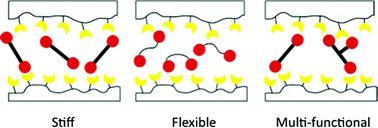The role of maleimide structure in the healing of furan-functionalized epoxy–amine thermosets†
Abstract
The healing efficacy of solution-based healing agents for a furan-functionalized epoxy–amine thermoset was investigated. In particular the effects of multimaleimide (MMI) structure and solvent type on healing behaviour were explored. Two major modes of healing are observed: Diels–Alder bonding across the crack surfaces and mechanical interlocking promoted by solvent-induced swelling. MMI structure and concentration influence the degree of Diels–Alder bonding across the crack, while solvent selection affects both healing modes. It was observed that the healing agent structure influenced the healing efficiency of the thermoset at short healing times (<1 day), and long-term healing (20 days) showed statistically insignificant differences in healing for the MMI structure studies, with approximately 90% recovery of a sample's initial strength in all cases. The effect of the solvent on healing efficiency was studied using toluene and dimethylformamide (DMF). The results provide guidelines for determining the composition of healing agent solutions needed to optimize the healing performance of furan-functionalized epoxy–amine polymer networks.

- This article is part of the themed collection: Self-healing polymers

 Please wait while we load your content...
Please wait while we load your content...